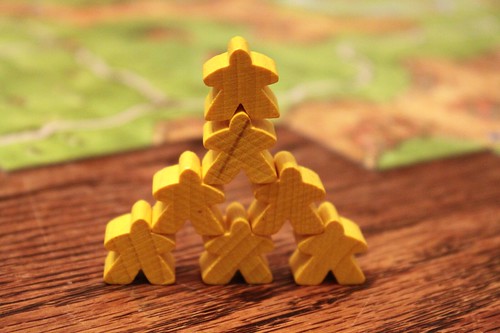Carcassonne is a boardgame, played with a set of tiles which very abstractly represent medieval France: individual tiles will have some combination of sections of city walls, fields, roads, monasteries and the occasional copse of trees. In addition to these tiles, each player has a set of seven followers, little wooden dudes in a variety of ostentatious colours. Followers are called “meeples” by the Serious Board Gaming Community, because the Serious Board Gaming Community is absurdly twee.

The goal of the game is to score points by building and dominating features of the nascent French state. Each turn, you draw a tile and place it adjacent to those placed before, and then may place one of your followers on the newly-placed tile’s terrain features. Those placed on roads, cities and cloisters are removed when those features are completed.
Those placed on fields (farmers) are laid down to show that they are never removed. I like to picture them lounging there, singing the opening stanzas of “Baba O’Riley” ad nauseam. At the end of the game, farmers score points for every completed city their fields touch.
Of course, it’s never that simple. While you can’t place a follower on a feature that already has someone else’s follower on it, it’s pretty simple to set up the same feature nearby but not actually connected, and then connect it on a later turn. If all sides have the same number of followers on the feature when it’s completed, (or at the end of the game) they all score. If one side has a majority, the losers get nothing; Democracy’s a bitch, ain’t it? Thus the larger and more grandiose a feature is, the more likely other players will involve themselves or even seize control.

The flow of the game tends toward a combination of open squabbling for control of cities and sub rosa farm wars. Cities are the most intuitive to build and are your mainstay for points in the normal course of play, but also make it easy for other players to involve themselves or delay completion. Farmers have the potential to score huge numbers of points, but every one you lay down is a follower that can’t be used for the rest of the game.
Roads can snatch a point or three and are relatively easy to cap off, but their main use is blocking off other player’s farms so they can’t reach cities or absorb your farms into a Maoist collective. Cloisters are an easy score in most cases, but they can tie up a follower for a long while or, if the fates are cruel and your opponent devious, the rest of the game.
In all, it’s pretty much the ideal of the “intuitive rules, complex strategy” school of boardgames (“eurogames”, to use the hep nerd lingo). Carcassonne even avoids the main pitfall of most eurogames, in which the winner is often obvious by the third round. The final farmer count can completely upset everything which has gone before.
Yet, despite all this excellent design, I’ve never had a satisfying session of the wood-and-cardboard version of the game. The exactness needed to place a tile, the inevitable table bump which scatters tiles and followers, the endless bookkeeping, all leach away the joy of pure dickish strategy.

By contrast, the Xbox Live Arcade version is dickish strategy defined. Freed from the constraints of the real world, with the computer keeping tally of the score and reminding you which moves are legal, you’re free to concentrate on using the entirely non-confrontational game mechanics to manipulate your opponents into doing your bidding.
The simplicity of the controls leaves your mind free to smack-talk, drink, have profound philosophical discussions and make up lyrics for the charmingly inane two-minute loop of Ren Faire music. Automation turns a compelling but frustratingly fiddly boardgame into a half-hour battle of wits which all but demands rematch after rematch until suddenly it’s three in the morning.

Like most boardgames published in the modern era, the cardboard Carcassonne supports the basic game with various supplements which add inns, dragons, giants, towers and pigs. The only supplements currently available for the Xbox version are two versions of the River expansion (one of which comes free with download), which add a touch of randomness to the starting setup of the game but aren’t remarkable enough to be worth paying for; and the King & Baron expansion, in which the players who built the largest city and road respectively gain points for every feature of that type at game end. These bonuses don’t change the basic strategy much, but the seven extra tiles included when you play with the new rules add a surprising amount of novelty once you’ve grown used to the basic mix.
The transparency of the game is what makes it ideal for local multiplayer. There’s no hidden information, just random tiles and strategic manoeuvring. Other boardgames obviously don’t have this luxury: The Settlers of Cataan, to name another of BoardGameGeek’s beloveds, has to be online-only to support the necessary opacity. Of course, cardboard Settlers is a less fiddly game overall, and you can arrange the city tokens into Swastikas and make tired jokes about German game designers, so the boxed version retains its appeal.

As for Carcassone, despite the loss of the always-appealing pig-farming supplement, the electronic version trounces the box. It’s a gaming experience, full of smug accomplishment, eleventh-hour victories and elaborately cursing out your rival for working one more follower into your megacity than you did. It’s damn well worth the ten bucks or so.
(The author would like to thank Flickr users oosp, Special*Dark and gamerscoreblog for providing the images used in this article via Creative Commons.)
* Yes, the game is about France. But “French Kings” doesn’t scan. Get the game, you’ll see what I mean.
No comments:
Post a Comment